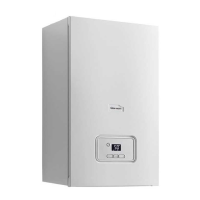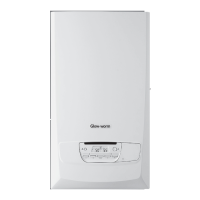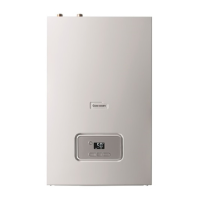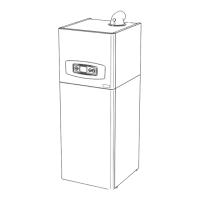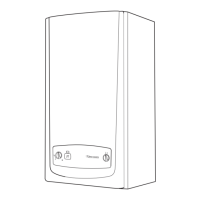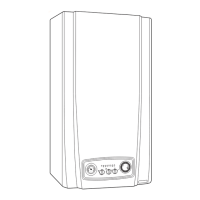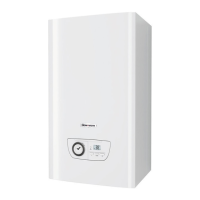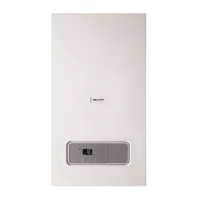13
221469B
4 Heating System
4.1 General Notes
The boiler is intended for use in a sealed system only.
4.2 Safety Valve
The safety valve is an integral part of the boiler.
It cannot be adjusted but has a manual test device.
4.3 Pressure Gauge
A pressure gauge is incorporated into the boiler to indicate the
system pressure.
The gauge has a cold fill set pointer.
4.4 Pump
The circulation pump is integral with the boiler.
The remaining circulating pressure head available from the
boiler is shown in diagram 4.1, Grundfos or diagram 4.1A, Glow-
worm Wilo.
4.5 Expansion Vessel
The boiler has an integral expansion vessel with a capacity of
8Litres, (1.76gall). If the system water content exceeds the
maximum quoted in Section 1, Data, an additional vessel
should be connected into the system as close as possible to the
central heating return connection of the boiler, see diagram 4.2.
The pressure shall not be less that the static head at the point
of connection, that is, the height of the top point of the system
above the expansion vessel.
4.6 Flow Rate
A valve must be incorporated in the main flow or return of the
system, valve “A” shown in the flow diagram 4.2. This valve
must be lockable and positioned so that inadvertent closure or
unauthorised interference is not possible. The design differential
can be between 11
o
C (20
o
F) and 17
o
C (30
o
F), dependent upon
the system resistance and the available pump head.
Grundfos Pump
The pump adjuster should normally be left at maximum (3) but
in some cases it is permissible to adjust the pump to a lower
setting (2), see diagram 4.1.
To use diagram 4.1 start with the required heating system load.
In the example shown the maximum boiler output has been
chosen, 17.6kW (60,000Btu/h).
Draw a horizontal line from the required system differential
temperature axis to intersect the curve.
In the example 11
o
C (19.8
o
F) has been chosen,
shown - - - - -. At the point of intersection draw a vertical line to
cross the pump curve, from this point draw a further horizontal
line to determine the available pump head. In the example 1.9m
(6ft4in) is available. A greater pump head can be achieved by
choosing a higher system differential temperature, up to a
maximum of 4.0m (13ft) at a system differential of 17
o
C (30.6
o
F).
The system must be designed such that the available pump
head is not exceeded.
If the heating system load is less than 13.2kW (45,000Btu/h)
then it is permissible to adjust the pump setting to (2),
shown . This results in an available pump head of
2.1m (7ft). This is the maximum that can be achieved with the
pump at this setting.
Glow-worm Wilo Pump
The pump adjuster should normally be left at maximum (2) but
in some cases it is permissible to adjust to a lower setting (1),
see diagram 4.1A.
To use diagram 4.1A start with the required heating system
load.
In the example shown the maximum boiler output has been
chosen, 17.6kW (60,000Btu/h).
Draw a horizontal line from the required system differential
temperature axis to intersect the curve. In the example 11
o
C
(19.8
o
F) has been chosen, shown ———. At the point of
intersection draw a vertical line to cross the pump curve. From
this point draw a further horizontal line to determine the available
pump head. In the example 1.9m (6ft3in) is available. A greater
pump head can be achieved by choosing a higher system
differential temperature, up to a maximum of 4.0m (13ft) at a
system differential of 17
o
C (30.6
o
F). The system must be
designed such that the available pump head is not exceeded.
If the heating system load is less than 13.2kW (45,000Btu/h)
then it is permissible to adjust the pump setting to (1),
shown . This results in an available pump head of
4.2m (13ft9in). This is the maximum than can be achieved with
the pump at this setting.
4.7 Bypass
It is essential that a bypass is fitted in all installations, 22mm o.d.
minimum. The bypass must have a lockable valve “B” in
diagram 4.2, incorporated in a position so that inadvertent
closure or unauthorised interference is not possible.
The bypass MUST be fitted before any system control. A
radiator bypass is NOT recommended.
4.8 Make-up
Provision should be made for replacing water lost from the
system using a make up bottle mounted in a position higher than
the top point of the system, connected through a non-return
valve to the return side of the heating circuit, see diagram 4.2.
Alternatively, provision for make-up can be made by pre-
pressurisation of the circuit
4.9 Filling Sealed Systems
Provision for filling the system at a low level must be made.
Three methods of filling are shown in diagram 4.3.
There must be no permanent connection to the mains water
supply, even through a non-return valve.
NOTE: It is important that fittings used for connection to potable
water comply with the water undertakers requirements.
4.10 Corrosion Inhibitor
If an inhibitor is to be used in the system, contact the inhibitor
manufacturer so that they can recommend their most suitable
product.
When fitting the boiler into an existing system, special care
should be taken to drain the entire system, including radiators,
then thoroughly cleaning out before fitting the boiler whether or
not adding an inhibitor.
